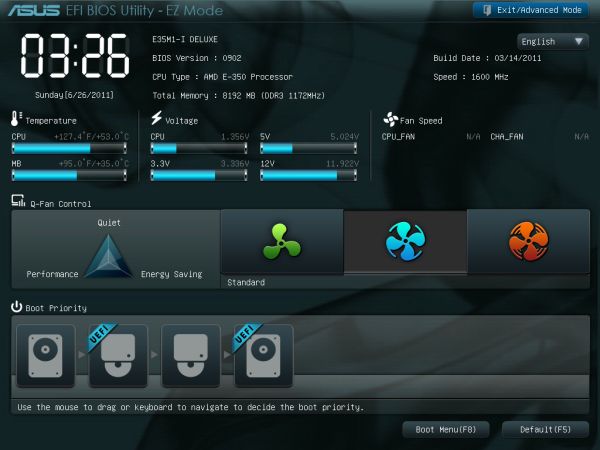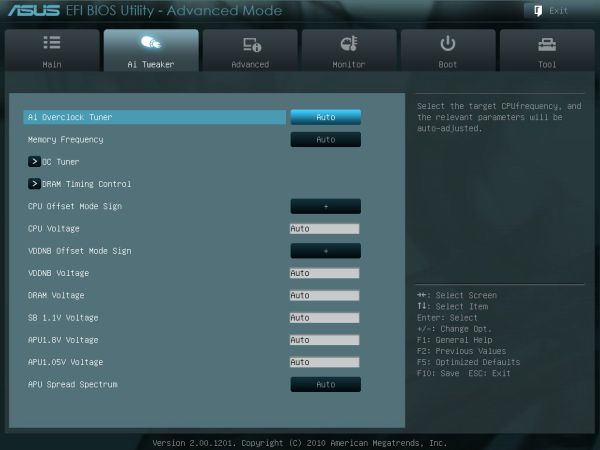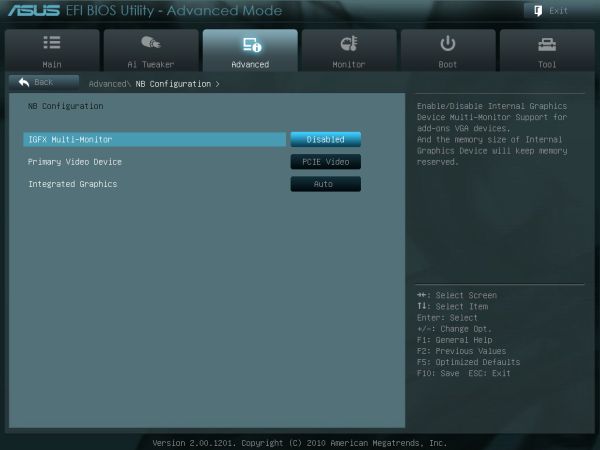Fusion E-350 Review: ASUS E35M1-I Deluxe, ECS HDC-I and Zotac FUSION350-A-E
by Ian Cutress on July 14, 2011 11:00 AM ESTBIOS
The ASUS BIOS solution for Fusion is essentially identical to what we've seen with the Sandy Bridge boards this year - the graphical UEFI implementation, but tailored to the Fusion interface. The front 'EZ mode' (easy, for Brits like me who say 'zed', not 'zee') contains the basic data we want to see - the BIOS version, the CPU, temperatures, voltages, fan speeds, three choices for performance and a quick boot management. This is the cream of UEFI front page implementations, for which ASUS should be applauded. Pressing F12 takes a nice screenshot too.
In advanced mode, 'Ai Tweaker' is where the important action is. First two options are the APU Frequency and Memory Frequency options, followed by OC Tuner (which acts exactly like the Turbo Key switch on the motherboard itself, by applying a default 5% overclock on the next boot) and the memory timing screen.
I actually found a small error in the BIOS here - if you select a manual bus speed overclock, say to 110 MHz, the Memory frequency options change to reflect this 10%, to 880 Mhz and so on. However, if you then decide not to apply the overclock and select 'Auto' on the Ai Overclock Tuner, the Memory Frequency values are stuck at the 10% overclocked values, even if on the next boot they will actually be based off the 100 MHz clock. It's just a small coding error, but odd it wasn't picked up during testing.
Also of interest is the 'NB Configuration' menu. Judging by these options, if you want to run a multi-monitor setup from the integrated GPU (so a HDMI 1.3b and DVI), this option will need to be enabled. However, the help menu mentions VGA devices - whether that explicitly means analog devices or in general video outputs, I'm not sure, but there's no VGA output on this board. So whether it's left over from other boards (the E35M1-M Pro does have a VGA) when they were making this BIOS, again, I'm not sure.
The monitor screen shows us just how hot the CPU is at idle under the passive heatsink - at the time I took this screenshot, we have a CPU running at 52ºC at 1.326 V. In the boot menu, we have the option for a one-off boot device selection, which I think should be a requirement on all future BIOS versions from every vendor.
Just a small after note - the shipping BIOS on the ASUS board is a little unstable. If left alone for a short while, the BIOS will freeze and the only way to fix it is to perform a soft reset. This issue is supposedly fixed with the 0902 BIOS though.
Overclocking
For the ASUS board in this roundup, overclocking was a fraction harder than the ECS. There are two ways to initiate an overclock - from the BIOS/UEFI, or via the Turbo Key II button on the motherboard itself. With the Turbo Key II, we get an instant 5% overclock to take the base speed from 100 MHz to 105 Mhz, and with a 16x multiplier, from 1600 MHz to 1680 MHz. The OC Tuner option in the BIOS has this effect too.
The other alternative is manually adjusting the bus speed from the BIOS. Now as these boards already come with CPUs, the results between boards will be different because of the silicon. With the BIOS, I left the voltage on auto and pushed the bus speed to 110 MHz without issue. At 114 MHz, the board successfully booted but failed the array of 3D iGPU tests in our bench suite. I adjusted it down by 1 MHz until our tests were stable - in the end, only 111 MHz (1776 MHz) was stable enough.
At this level of overclock, the 3D Movement benchmark results were improved by 11.7 % in single threaded mode and 11.0 % in multi threaded. GPU results were considerably different - 21% increase in Metro 2033, 17.3% in Dirt2 and 36% in Left4Dead2, confirming that the CPU or memory is quite the bottleneck in these scenarios.



















67 Comments
View All Comments
sprockkets - Thursday, July 14, 2011 - link
I have the AsRock board. I get 18w idle and 24w under load via a killawatt device. Granted it uses an 80w power supply, but I'm kinda wondering how you got 59w for something that is practically the same setup in each board.IanCutress - Thursday, July 14, 2011 - link
I was using a less than ideal power supply for the power draw tests which was very inefficient in this range (<20% of maximum power), and unfortunately I don't have anything more appropriate at hand to test with. The comparisons (I believe) between the boards are more than relevant though. I will hopefully rectify this in future reviews of lower powered systems.Ian
formulav8 - Thursday, July 14, 2011 - link
Why didn't you wait to do power consumption tests then?bah12 - Thursday, July 14, 2011 - link
While not ideal, I'd say the whole point of this article was to illustrate the differences in the boards. Thus as long as they all suffered from the same inefficient PS, the information is not useless in that you can still draw a conclusion based on the differences at the board level. All and all, not ideal but useful.BushLin - Friday, July 15, 2011 - link
I once tried to reason with the fanboys at AMDZone on Anands behalf, defending that the reviews here were objective... I think I'm starting to believe that their might be some truth in their beliefs that the odds are stacked against AMD when their products are reviewed on here.At best, this review is a misguided. It focuses far too heavily on areas these systems are not aimed at, misinforms (or fails to inform) on areas that it's market are interested in and answers stupid questions that no-one is asking. Testing a GTX 580 with an E-350 at 4x PCI-E... really? Why not test out how well these work as a HTPC compared to something like ION and the latest Atom?
At worst, this review could almost be seen as a deliberate undermining of a technology that's potentially superior to it's Intel's offering and how often could you honestly say that since Core2?. Most of the tests are irrelevant (or become irrelevant when comparing to much higher TDP chips), the one test you did manage to do which is very relevant (power consumption) was so high that it prompted me to look at other reviews and take the time to write this comment!
This review has idle power consumption as at least 36w, Xbit have it at 7.3w even with a 880w PSU. One of these reviews has it very wrong, I know which one I'm more inclined to believe.
http://www.xbitlabs.com/articles/cpu/display/amd-e...
IKeelU - Friday, July 15, 2011 - link
I have to agree with your assessment of the review.- These boards are aimed at HTPC market, but the review was focused...elsewhere (frankly, I can't tell what the focus was).
- How is the audio quality? I was very interested in the ASUS board until I noticed it doesn't have 6-channel direct out. This is important!
- Another, less important, point: The features/specs for each board should come first. Double points for a feature comparison table.
AnandThenMan - Friday, July 15, 2011 - link
It is extremely unfortunate that Anandtech has sacrificed their integrity when it comes to reviewing some of AMD's products. I really hope that more and more people are made aware of what is going on, these reviews are downright dishonest.The most important question people need to ask is, why is this happening? What is the incentive for Anandtech.com to publish these misleading reviews?
ET - Saturday, July 16, 2011 - link
Can you explain what is dishonest or misleading about this review? I agree that it could be better, but I don't see anything to indicate that anything was falsified here.medi01 - Sunday, July 17, 2011 - link
Seriously?Cough "This review has idle power consumption as at least 36w, Xbit have it at 7.3w even with a 880w PSU. ", cough?
Oh, it's irrelevant, because we're comparing motherboards of the same platform? Orly? What if I read this, say "OMG it consumes so much energy" and go buy Atom?
Tell me how to get that 36w idle thing, what kind of PSU should be used, to justify 7.3w (with bloody 880w PSU!!!!) vs 36w please?
What are 5850 580gtx doing in this review?
Shameless...
Finraziel - Thursday, September 1, 2011 - link
Monstrously late reply... but I just can't not leave this comment... Did any of you actually read the xbit article? Those power draw measurements are measured between the PSU and the components, only measuring what the components are actually using, completely ignoring the efficiency of the PSU (the way xbitlabs has been testing for years I might add). So the fact that they were using an 880W PSU has absolutely zero bearing on their readings.Granted, it's still a shame that these boards couldn't have been tested with something like a pico psu, and I do agree the article could have been better (for instance, how much noise does that tiny fan on the ECS board actually make? apart from an easily missed remark in the conclusion nothing is said about it), but it's not as bad as you people are making it out to be.